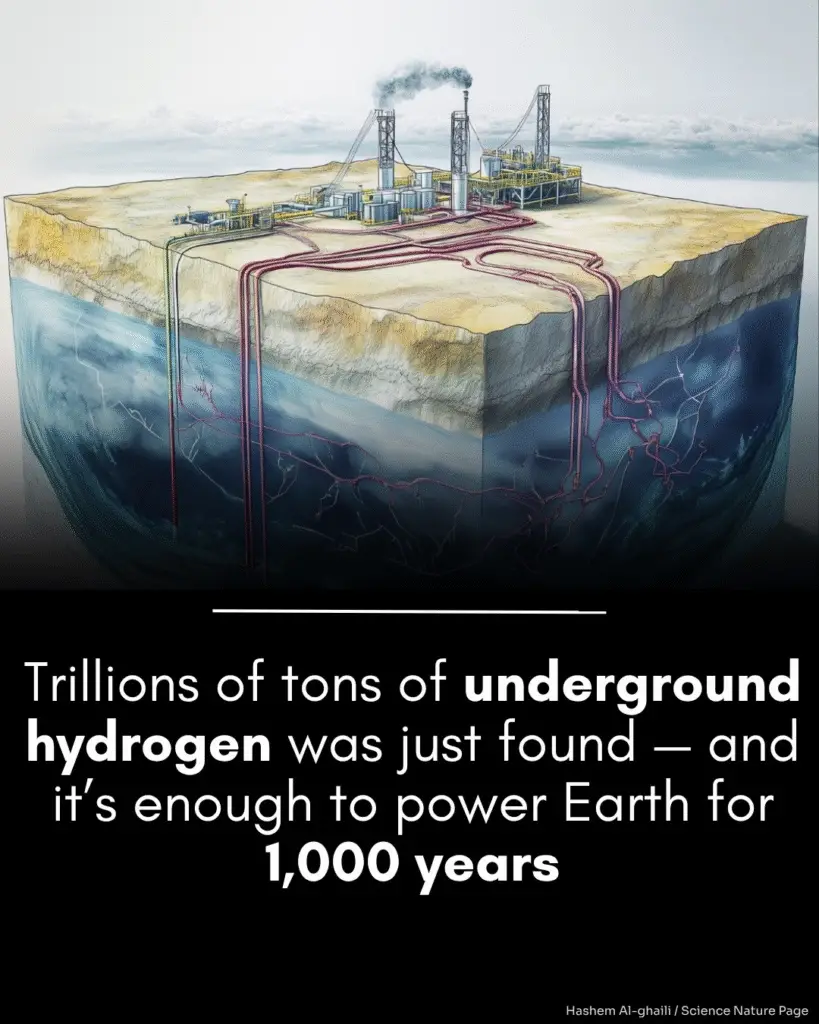A quiet but seismic shift is taking place beneath our feet. While most eyes in the energy world have been focused on solar panels, wind turbines, and electrolyzers powered by renewables, a different form of hydrogen is slowly sparking interest—literally and figuratively. This form doesn’t come from water-splitting or methane reforming. It comes from rocks.
Known as geological hydrogen, this naturally occurring gas is formed and trapped within Earth’s crust. In places like Bourakebougou, Mali, where a borehole meant to find water instead released a plume of nearly pure hydrogen, the energy world is beginning to realize that hydrogen doesn’t always have to be made—sometimes, it can simply be found.

What is Geological Hydrogen?
Geological hydrogen refers to molecular hydrogen (H₂) produced by natural geochemical processes underground, often over human-relevant timescales. Unlike fossil fuels or hydrogen derived from water using electricity, this hydrogen is formed through chemical reactions between minerals and water—chiefly serpentinization, where iron(II)-rich rocks like olivine react with water to release hydrogen gas.
Other production mechanisms include:
- Radiolysis: Water molecules are split by natural radiation from the decay of uranium and thorium.
- Primordial Degassing: Ancient hydrogen from Earth’s interior seeps out through tectonic faults.
- Biotic and Abiotic Filtering: Some hydrogen is consumed by microbes or reacts with other subsurface materials before accumulating in reservoirs.
These reactions occur naturally and constantly. But until recently, the idea of accessing this hydrogen—especially in commercially viable quantities—was barely more than an academic curiosity.
Bourakebougou: Ground Zero for Natural Hydrogen
The global geological hydrogen story starts in earnest in Bourakebougou, a remote village in southwestern Mali, where a failed water well dug in the 1980s revealed a strong gas flow. After a dramatic and accidental ignition, engineers discovered the gas wasn’t methane—it was hydrogen.
Local businessman Aliou Diallo later purchased exploration rights and confirmed the gas was 98% pure hydrogen. His company, now known as Hydroma, has since been using that hydrogen to generate electricity, making Bourakebougou the only site in the world currently producing geological hydrogen at economic scale.
Global Race to the Subsurface
Hydroma’s success has lit a fire under a previously dormant field. Today, approximately 50 start-ups and developers are exploring geological hydrogen prospects across the globe. At least 200 test wells are being drilled, mostly in secret as firms vie to secure mineral rights and prove out reserves before competitors catch on.
The U.S. alone holds immense promise. A U.S. Geological Survey (USGS) study published in 2024 estimates 5.6 trillion metric tons of hydrogen are trapped in geological formations worldwide, with 15–31 million metric tons generated annually. Even if just a fraction of a percent is accessible, it could surpass current global hydrogen production, potentially changing the trajectory of the energy transition.
Like Us on Facebook!
In a follow-up study, the USGS mapped out likely hydrogen-bearing formations in the 48 contiguous states, highlighting prospects in the Midwest, Appalachians, Rocky Mountains, and Pacific Coast.
Subscribe Us on YouTube!
The Economics of Geological Hydrogen
The biggest promise of geological hydrogen? Ultra-low cost.
Industry analysts believe that once proven, geological hydrogen could be produced for as little as $1 per kilogram—dramatically cheaper than hydrogen from:
- Electrolysis with renewables: ~$7/kg
- Methane reforming with carbon capture: ~$3/kg
This cost is lower than even fossil-derived hydrogen, making it one of the most disruptive potential energy sources of the decade. It aligns perfectly with the U.S. Department of Energy’s Hydrogen Earthshot goal: $1 for 1 kg of clean hydrogen in 1 decade.
Stimulating Hydrogen: Not Just Finding, But Making
Two paths define this new industry:
- Exploration and extraction of naturally accumulated hydrogen in underground pockets, similar to oil and gas drilling.
- Stimulation of hydrogen production by injecting water into iron(II)-rich rock formations, triggering in-situ serpentinization.
The second approach positions underground rock layers as chemical reactors, turning them into long-term hydrogen factories. This can even go beyond hydrogen. MIT professor Iwnetim “Tim” Abate is researching how such reactions could be used to produce ammonia, bypassing the carbon-intensive Haber-Bosch process.
Abate’s team demonstrated bench-scale yields from reacting olivine with aqueous nitrate, theorizing that this “Abate cycle” could produce 235 million tons of ammonia annually at $0.46–$0.55/kg—potentially lowering to $0.30/kg if nitrogen from air can be used.
A Burgeoning Industry
Investors have taken note. Major deals include:
- Fortescue paid $21.9 million for 40% of HyTerra, which is drilling in Kansas and targeting 250,000 tons of hydrogen and 2,200 tons of helium.
- Koloma, the sector’s biggest player, raised $247 million in a Series B round, with backing from Amazon and Breakthrough Energy Ventures.
Firms like Helix Exploration, H2Au, and Helios Aragon are active in the U.S., Spain, and South Africa. But most are still tight-lipped, keeping their explorations and intellectual property under wraps.
Risk vs. Reward: A Numbers Game
Despite the hype, the field remains high-risk and largely unproven outside of Bourakebougou. Geological exploration has a historically low success rate—often 1 in 10 wells find something valuable. But the upside is massive.
As Owain Jackson, CEO of H2Au, put it: “There is a macro risk around natural hydrogen that is coming down daily. If we find something, it could be really, really cheap. Game-changingly cheap.”
Challenges Ahead
- Detection Difficulty: Hydrogen lacks the strong spectral signatures of fossil fuels, making it harder to detect with traditional tools.
- Regulatory Gaps: Many jurisdictions don’t have clear frameworks for hydrogen drilling or mineral rights.
- Chicken-and-Egg Market: Hydrogen users won’t commit until supply is guaranteed, but producers won’t scale without buyers.
- Environmental Impacts: The long-term effects of stimulating hydrogen underground are still not well understood.
The Road to Scale
But the advantages are real. Geological hydrogen could provide a clean, dense, storable energy source that doesn’t depend on weather or grid infrastructure. The industry benefits from decades of fossil fuel know-how—from drilling techniques to regulatory strategies—giving it a head start over other green technologies.
As Zainub Noor from Halliburton Labs noted, “This will be the least expensive source of hydrogen as soon as technical feasibility is proven. We strongly believe this will be one of the biggest breakthroughs of this era.”
Conclusion: A New Underground Revolution?
While the path to commercialization is far from clear, geological hydrogen may be the dark horse of the global energy transition. It could break the deadlock holding back the hydrogen economy, lower costs dramatically, and unlock clean energy in places without access to renewables.
“There’s chemical potential beneath our feet,” said Doug Wicks of ARPA-E. “If the engineers can figure out how to control it and harness it.”
If geological hydrogen succeeds, it won’t just supplement the clean energy revolution—it could power it.


















